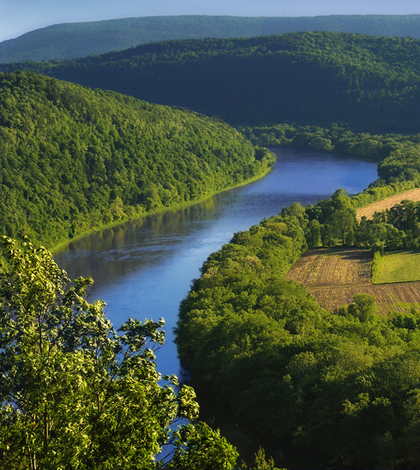Study finds alkalinity on the rise in Eastern U.S. rivers

A sprawling study of rivers in the Eastern U.S. has revealed an unexpected and widespread effect of acid rain: Alkalinity is on the way up in a majority of streams, which actually increases their ability to neutralize acid.
The rivers where researchers found alkalinity on the rise include several that feed public drinking water supplies of Eastern cities. Higher alkalinity has the potential to increase the hardness of water, affecting its taste and speeding corrosion of pipes and infrastructure. It can also have ecological effects.
The study, published in the online edition of the journal Environmental Science and Technology, analyzed trends in alkalinity at 97 stream sites over 25 to 60 years, depending on the site. The sites collectively represent 260,000 square kilometers of drainages spanning from New Hampshire to Florida.
Of the 97 sites, 62 showed increasing trends. None of the sites showed decreases.
“That was surprising that so many sites showed that,” said Sujay Kaushal, an associate professor of geology at the University of Maryland and lead author of the study. “We weren’t expecting that.”
The growing alkalinity is likely a lagging effect of acid rain, which accelerated the weathering of rocks in watersheds, breaking them down into antacid materials that accumulate in large rivers. Dissolving rocks can increase calcium in the water, which contributes to water hardness. In addition to the effects on drinking water supplies and infrastructure, high alkalinity can lead to ammonia toxicity.
The trend was especially pronounced where carbonate rock like limestone were prevalent in the watershed. Other landscape and environmental factors that were associated with growing alkalinity included elevation and the pH of precipitation in the watershed. The higher the elevation and the more acidic the rain in watershed, the more likely it was for its streams to show increased alkalinity.
The data also showed alkalinity on the rise in some urban areas that weren’t necessarily high elevation sites or within watersheds dominated by carbonate rock. One possible reason for that, Kaushal said, could be the prevalent concrete in cities.
“In the Eastern U.S. and the Midwestern U.S., we have these cities that are aging,” he said. “Sometimes the concrete structures degrade over time. Concrete can have a lot of limestone in it. When it dissolves, it can cause the water to become more alkaline as well.”

Appalachian streams are vulnerable to chemical weathering due to carbon-rich rocks, erosion, acid rain and mining runoff. (Credit: Sujay Kaushal)
The study relied on data from the U.S. Geological Survey, the U.S. Environmental Protection Agency’s Chesapeake Bay Program, and the Hubbard Brook Experimental Forest–a long-term ecological research station in New Hampshire.
Past research from Hubbard Brook produced the first evidence of acid rain in North America. One of the scientists involved in that effort, Gene Likens is a co-author on the alkalinity paper. Kaushal said that even Likens was initially caught off-guard by the counterintuitive finding that acid rain could lead to a rise in alkalinity in rivers.
“He discovered acid rain, and he also was amazed and surprised by it,” Kaushal said. “We scratched our heads too, at the very beginning. But that’s why I think we’re onto something, actually. There is something new here.”
The majority of the alkalinity in these rivers is in the form of bicarbonate, an inorganic form of carbon. Kaushal drew a parallel between increasing bicarbonate in rivers with another form of inorganic carbon on the rise in the environment: carbon dioxide.
“Even though they’re caused by different processes, they’re still fundamental changes to the carbon cycle,” Kaushal said. “One is appearing in water, and the other is in the atmosphere.”
Now that long-term trends of bicarbonate increasing in water have been document, the door is open to researching the larger effects on the environment.
“Just like like CO2 question, what are some of the impacts of this?” he said. “Now we’ve documented that these trends are occurring, what are some of the implications?”
Top image: Site along the Susquehanna River were among those wher researchers found a long-term trend of increasing alkalinity (Credit: Nicholas A. Tonelli, via Flickr




0 comments